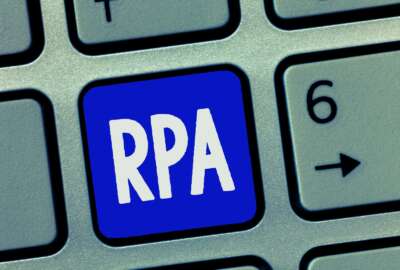

The robotics process automation community of practice will release a new RPA playbook for agencies next month. Gerard Badorrek, the RPA community's chair, said the...
The General Services Administration has a lofty goal in mind for 2020 and beyond: help civilian agencies free up nearly $1 billion worth of productive time across government through robotics process automation.
Gerard Badorrek, GSA’s chief financial officer, believes the goal is possible with a federal workforce of roughly 2 million employees.
“If you [saved] seven, eight hours per employee at an agency, you get to the billion dollars,” he said Wednesday during an Association for Federal Information Resources Management panel discussion in Washington D.C. “At GSA we’re close to six hours per employee. Not all agencies can do that much. But if you can hit that on average, you’re going to free up a billion dollars in capacity. Agencies will be at different stages.”
That’s where the RPA community of practice, which Badorrek also leads, will play a critical role. The community formed last April and has been listening to agencies’ challenges in implementing and managing RPA applications since then.
Like most major initiatives in government, some agencies are more advanced than others in exploring and using RPA. But the community of practice, which now has more than 700 individual members from more than 50 agencies, is collecting those use cases and best practices from across government.
Those stories and lessons will inform a new RPA playbook, scheduled for release some time in January, Badorrek said.
The playbook, he said, will walk agencies through the stages of selecting, choosing and managing RPA projects.
Spreading best practices, Badorrek said, will help agencies identify work processes within their own organizations that can be automated, allowing their employees to work on other, more high-value activities.
But the RPA community of practice is also focused on collecting agency ideas and use cases so others won’t start over and replicate the same project.
“You don’t want to shut things down, but you don’t want bots being built all over the place,” Badorrek said. “Each agency has to think about an approach that will allow good ideas to go forward, but you have to think about what you want to centralize and control. It might be the platform. It’s certainly going to be the credentialing policy. It’s the security policy around bots, but based on the structure of your agencies, the leaders have to think about how much control do we want to invoke over our agency?”
The community of practice is also building a use-case library of successful RPA applications. Community members started by building a library for finance, and human resources will come next, Bado said.
Other governmentwide groups and councils are also focused on this question. Members of the chief acquisition officers council are also reviewing agency use cases and discussing what projects could potentially serve a governmentwide purpose.
GSA itself has taken on this approach, Badorrek said. His office has searched for common inefficiencies across all 11 GSA regions. The agency has approached everyday tasks with an “eliminate, optimize, automate approach,” prioritizing projects that can eliminate common inefficiencies through automation across all of GSA.
The Office of Personnel Management is also part of the conversation, said Michael Rigas, the agency’s deputy director. OPM is collecting agencies’ RPA best practices too, but the agency is more focused on the technology’s human resources impact.
OPM in May released a reskilling toolkit and executive playbook for workforce reshaping, resources that are ultimately supposed to help agencies better prepare and talk to their employees about the impacts emerging technology will have on their jobs.
“Some of the recent analysis that we’ve done shows that only 5% of jobs are actually in a state where they can be completely automated,” Rigas said. “We’re not looking at eliminating jobs; we’re looking to eliminate repetitive tasks.”
For Badorrek, preparing the workforce for RPA and other emerging technologies is more about cultivating employees to be change managers, rather than training them on the technicalities of the technology.
“You can see an application, you can get excited about it,” he said. “But if you’re someone who has to sign off on some aspect of a bot going into production, you’re going to be very cautious. To go through that process and to have leaders driving this that will help the agency and the employees get more comfortable with implementing something that’s unknown to them is really where we need the expertise.”
Copyright © 2025 Federal News Network. All rights reserved. This website is not intended for users located within the European Economic Area.
Nicole Ogrysko is a reporter for Federal News Network focusing on the federal workforce and federal pay and benefits.
Follow @nogryskoWFED

